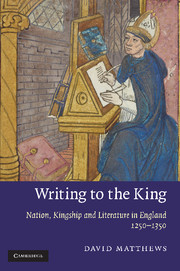Book contents
- Frontmatter
- Contents
- Preface
- Abbreviations
- Introduction
- 1 Defending Anglia
- 2 Attacking Scotland: Edward I and the 1290s
- 3 Regime change
- 4 The destruction of England: crisis and complaint, c.1300–41
- 5 Love letters to Edward III
- Envoy
- Appendix: The tail-rhyme poems of Langtoft's chronicle
- Notes
- Bibliography
- Index
- CAMBRIDGE STUDIES IN MEDIEVAL LITERATURE
2 - Attacking Scotland: Edward I and the 1290s
Published online by Cambridge University Press: 07 May 2010
- Frontmatter
- Contents
- Preface
- Abbreviations
- Introduction
- 1 Defending Anglia
- 2 Attacking Scotland: Edward I and the 1290s
- 3 Regime change
- 4 The destruction of England: crisis and complaint, c.1300–41
- 5 Love letters to Edward III
- Envoy
- Appendix: The tail-rhyme poems of Langtoft's chronicle
- Notes
- Bibliography
- Index
- CAMBRIDGE STUDIES IN MEDIEVAL LITERATURE
Summary
TEACHING BRITISH TO THE ROMANS
Reclining on the dais with his nobles and knights after a great feast at Pentecost, the king is visited by a delegation from Rome, twelve men bearing olive branches in token of a peaceful mission. They deliver a letter which, read aloud, causes outrage in the court. Lucius Hiberius, who is variously, according to the source in which this story is read, procurator, senator, or emperor of Rome, denounces Arthur's conquest of Gaul and his failure to pay tribute to Rome, owed since the conquest of Britain by Julius Caesar. Lucius demands Arthur's presence in Rome, bearing the tribute. Like any good sovereign, Arthur immediately calls a council with his magnates in order to decide on a course of action. Cador, duke of Cornwall, speaks first, cautioning against the vice of idleness and welcoming the arrival of the letter with its promise of warlike action. Arthur then argues that the conquest of Britain by Caesar was unlawful and that no tribute is owed. The king of Scotland responds in support. It is agreed that Arthur will summon all his vassals and lead an invasion of Rome. Rome shall pay tribute to Britain, rather than the other way around.
This story ultimately goes back to the early twelfth–century version by Geoffrey of Monmouth in his Historia Regum Britannie, but it was retold through the centuries by all of Geoffrey's imitators. Each time, of course, it receives a new inflection.
- Type
- Chapter
- Information
- Writing to the KingNation, Kingship and Literature in England, 1250–1350, pp. 52 - 80Publisher: Cambridge University PressPrint publication year: 2010



